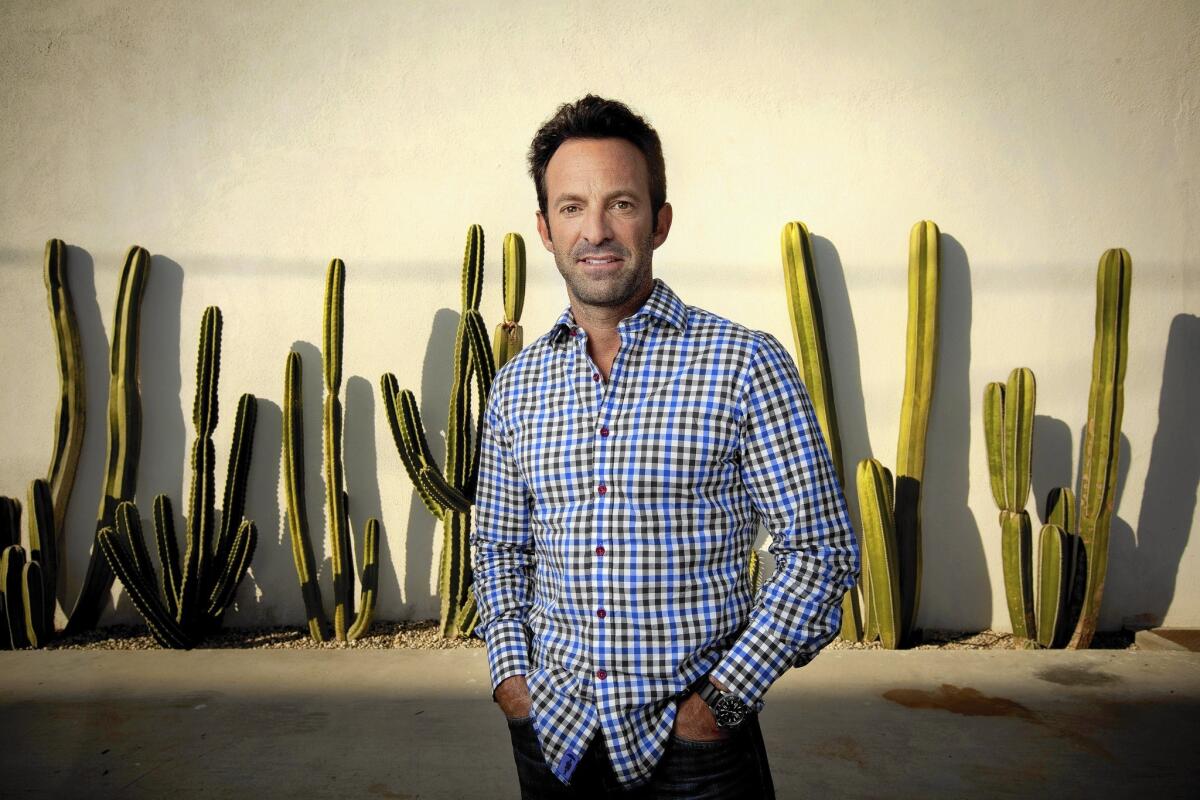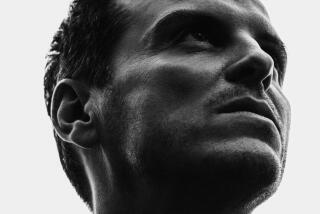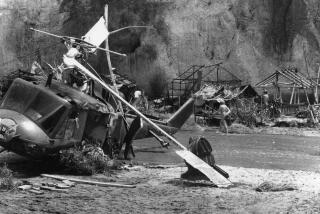‘Need for Speed’ director Scott Waugh’s need for reality

In a climactic car-chase scene in the new movie “Need for Speed,” a race car barrels into the back of a police SUV, sending the truck flying through the air.
To put viewers in the drivers’ seats, director Scott Waugh placed cameras inside the SUV so they could feel the sensation of the truck rotating in the air. He positioned cameras on the head of the stunt driver maneuvering the vehicle that collides with the SUV, and in the car driven by Tobey Marshall (“Breaking Bad’s” Aaron Paul) as he races by the chaos. Camera operators also took aerial footage from two helicopters flying above the melee.
The 12-second scene filmed on Lighthouse Road in Mendocino, Calif., took six hours of preparation.
“I want the audience to be inside the wreck and participate in it, rather than just sitting outside watching it,” said Waugh, 43. “That’s kind of my signature.”
ON LOCATION: Where the cameras roll
The DreamWorks Pictures movie, released Friday, is adapted from the popular Electronic Arts video franchise. The film — about a street racer played by Paul who joins a cross-country race to settle a score with an ex-partner who framed him — aims to evoke the car culture movies of the 1960s and 1970s, like “Vanishing Point” and “Bullitt.”
The reviews were weak but business was expected to be strong — it could open as the No. 1 film over this weekend.
The movie, released by Disney Studios, reflects the action-oriented filmmaking style of Waugh, who is a Hollywood rarity: a director who spent most of his career as a stuntman. Waugh spent 25 years crashing cars and performing other stunts for movies such as “Speed” and “Spider-Man” before making the unconventional transition to director, drawing on his experiences to bring audiences as close to the action as possible.
The riding-shotgun approach was a hallmark of Waugh’s previous movie, “Act of Valor,” a 2012 film about a group of active-duty U.S. SEALs directed and produced with his business partner, Mike McCoy. To keep it as real as possible, Waugh cast actual Navy SEALs rather than actors.
The $9-million film released by Relativity Media grossed more than $70 million at the box office and put Waugh on the radar of DreamWorks Chief Executive Stacey Snider.
PHOTOS: Box office top 10 of 2013 | Biggest flops of 2013
“It was so visceral I couldn’t help but get caught up in the thrill of it,” Snider said. “The fact that you could personally feel the energy of the characters made me feel that Scott would be great choice [to direct] ‘Need for Speed.’ ... Because it was based on a video game, we had to come as close as possible in approximating what you feel when you’re playing a video game and that’s what Scott promised — an immersive experience.”
More than 100 cars were used on the $66-million film. Those included a variety of classic muscle cars, including a Mustang especially designed by Ford topping out at 190 mph, as well as the 1969 Ford Gran Torino and 1968 Chevy Camaro. For European supercars, the production hired Reel Industries of Los Angeles to create 15 chassis and fiberglass shells for each model to avoid damage to vehicles that cost more than $1 million each.
Unlike most current action directors who rely heavily on computer generated images, Waugh eschews digital effects.
In “Need for Speed,” all the stunts were done by precision drivers and stunt performers on location rather than on a sound stage, Waugh said. (CGI was used only to remove crew members and wires from shots.) He also used as many as 40 cameras at a time to capture a single scene from all angles, relying on his own 25 years jumping, crashing and racing cars in movies and TV shows.
“We went back out on the road, traveling at high speeds and hanging out the side of the car to film this,” Waugh said. “I wanted the audiences to really feel what it’s like to drive 230 miles per hour.”
VIRTUAL TOUR: Hollywood’s Walk of Fame
On the set, crew members called it the Steve McQueen style of filmmaking, a reference to the close-up camera shots in his movies that made viewers feel like they are along for the ride.
It’s an approach he learned from his father, Fred Waugh, a renowned stuntman who favored putting the audience in the boots of those doing the stunts. The elder Waugh also invented the 35-mm helmet camera and an innovative hand-held camera called the Pogo Cam, paving the way for lightweight cameras used today, Waugh said. He dedicated the movie to his father, who died last year.
Scott Waugh grew up around stunts, watching his dad, a former circus performer, double for the original “Spider Man” in the 1970s TV series. His father’s best friend was celebrated stuntman-turned-director Hal Needham (“Smokey and the Bandit”).
Waugh’s childhood home in Sylmar included a trapeze and high-fall pads where he watched his dad practice stunts. When his family moved to Agua Dulce, Waugh learned to ride horses and dirt bikes, hanging out with the sons of other stunt performers.
“I grew up in the ultimate playground,” he said.
He was 12 when a friend of his dad’s offered him his first high-profile stunt job: riding a bicycle off a garage for a TV pilot directed by a first-time director named Ron Howard.
PHOTOS: Celebrities by The Times
Waugh continued doing stunt jobs during summers until he enrolled in the film program at UC Santa Barbara, where got a degree in fine arts. He briefly pursued a career in acting before returning to stunts to pay his bills as he waited an opportunity to become a filmmaker. “It was my form of waiting tables,” he said.
When a college friend asked him to help make a surfing documentary, “Step Into Liquid,” he jumped at the chance, spending four years on the project following surfers around the world as a second-unit director and editor.
He then partnered with his childhood friend McCoy, a former motocross champion and stuntman, to produce “Dust to Glory,” a documentary on the Baja 1000, an annual off-road race in Baja, Mexico.
After directing a string of action-oriented car commercials, Waugh and McCoy in 2006 launched their own company, Bandito Bros., a full-service Los Angeles studio that provides production as well as editing and visual effects services. “I wanted to create a place where we could work from start to finish on a movie and never leave the property,” Waugh said.
“Act of Valor,” which grew out of a commercial they did for the Navy, was their first feature film. The men joined a platoon and participated in full-training sessions with live ammunition to get close-up action shots. “Scott will put himself in the middle of the action like nobody else with the camera,” McCoy said.
Waugh, eager not to be pigeonholed as a military movie director, was drawn to the script for “Need for Speed,” which reflected his own lifelong passion for cars. He raced stock cars north of Valencia when he was in college.
The myriad car stunts required meticulous planning. One scene in which Tobey’s car jumps a hedge and flies 170 feet over a freeway took four months of planning and testing in a parking lot in Georgia before it was filmed on location in Detroit.
“I take safety extremely seriously because the people doing the stunts are my friends,” Waugh said. “We’re not daredevils.”
More to Read
From the Oscars to the Emmys.
Get the Envelope newsletter for exclusive awards season coverage, behind-the-scenes stories from the Envelope podcast and columnist Glenn Whipp’s must-read analysis.
You may occasionally receive promotional content from the Los Angeles Times.








